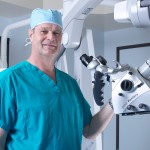Thoracic Epidural Arteriovenous Malformation (TEAM)
Thoracic Epidural Arteriovenous Malformation (TEAM) Disease is an arteriovenous malformation (AVM) that is located in the epidural space of the spinal column in the thoracic region. This area is outside the spinal cord but inside the vertebral canal of the spinal column.
An AVM occurs when veins and arteries share an abnormal connection and bypass the capillary system. This collection of arteries and veins becomes a tangled web and can wrap around the spinal cord causing pressure on the cord and in some cases deprive it of oxygen.
TEAM Disease primarily affects women between the ages of 20 and 45 and was discovered by DISC’s founder and CEO Dr. Robert Bray in 2009.
TEAM Symptoms
Symptoms of TEAM Disease may include upper back pain, weakness or numbness in the arms or legs, leg spasms, loss of balance and difficulty walking up and down stairs. Symptoms typically become progressively worse over time and are not brought on by any particular incident.
TEAM symptoms can often present as symptoms similar to other diseases such as multiple sclerosis, transverse myelitis, or spinal cord myelopathy. If you experience any of these symptoms, or notice any change in your motor skills, it is important to contact your doctor.
TEAM Diagnosis
Diagnosis is made upon completion of a thorough clinical exam in conjunction with a special gadolinium dye sequencing protocol that allows Doctors to get an image of the AVMs in this specific area. Other tests may be required to rule out other possible causes of symptoms.
Treatment
Warning: This video is of a live surgery and contains graphic images in a surgical setting.
Treatment is dependent on the progression of the disease. In most cases, surgical intervention is recommended to remove the growths and relieve pressure on the spine.
DISC’s team of skilled neurosurgeons perform an outpatient procedure called an intralaminar laminotomy that was developed by Dr. Bray. Using a minimally invasive approach under a high-powered microscope, small incisions are made in order to make holes into the epidural space and remove each AVM.
Recovery times have ranged from three to 14 months, based on the extent of damage to the spinal cord prior to surgery. To date, once the AVMs have been removed there is no evidence of their re-growth.
 Dr. Robert Bray Jr. is the CEO and Founder of DISC Sports & Spine. He discovered TEAM Disease in 2009 and is currently the only spinal surgeon in the world treating the condition.
Dr. Robert Bray Jr. is the CEO and Founder of DISC Sports & Spine. He discovered TEAM Disease in 2009 and is currently the only spinal surgeon in the world treating the condition.

About the author
discmdgroup DISC Sports & Spine Center (DISC) is a national leader in minimally invasive spine surgery, orthopedic surgery, and sports medicine care. Our spine surgeons set the standard in artificial disc replacement, spine fusion, discectomy, microdiscectomy and the full spectrum of spine procedures. The group’s orthopedic surgeons advance the state of joint preservation surgery and total joint replacement, including total knee replacement as well as total hip replacement. Our flagship surgery centers based in Newport Beach, Marina del Rey, and Carlsbad serve patients local to Los Angeles, Orange County and San Diego, as well as the rest of the country. Read more articles by discmdgroup.




